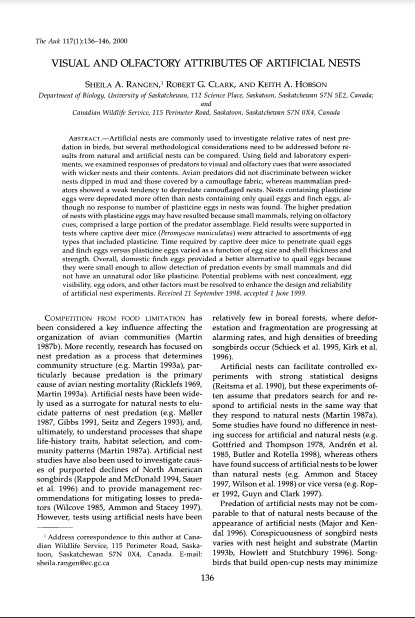Visual and Olfactory Attributes of Artificial Nests
Bosque Modelo:
Foothills
Temática:
Gestión forestal
Tipo de documento:
Artículo científico
Resumen
T.--Artificial nests are commonly used to investigate relative rates of nest predation in birds, but several methodological considerations need to be addressed before resuits from natural and artificial nests can be compared. Using field and laboratory experiments, we examined responses of predators to visual and olfactory cues that were associated with wicker nests and their contents. Avian predators did not discriminate between wicker nests dipped in mud and those covered by a camouflage fabric, whereas mammalian predators showed a weak tendency to depredate camouflaged nests. Nests containing plasticine eggs were depredated more often than nests containing only quail eggs and finch eggs, although no response to number of plasticineggs in nests was found. The higher predation of nests with plasticineggs may have resulted because small mammals, relying on olfactory cues, comprised a large portion of the predator assemblage. Field results were supported in tests where captive deer mice (Peromyscus maniculatus) were attracted to assortments of egg types that included plasticine. Time required by captive deer mice to penetrate quail eggs and finch eggs versus plasticine eggs varied as a function of egg size and shell thickness and strength. Overall, domestic finch eggs provided a better alternative to quail eggs because they were small enough to allow detection of predation events by small mammals and did not have an unnatural odor like plasticine. Potential problems with nest concealment, egg visibility, egg odors, and other factors must be resolved to enhance the design and reliability of artificial nest experiment
Información Bibliográfica
Autor:
Rangen, SA, RG Clark and KA Hobson.
Revista:
The Auk
Año:
2000
N°:
1
País :
Canadá
Páginas:
136 - 146
Volumen:
117
Idioma:
Ingles
Palabras claves
Model forest, Adaptatation, Canada, Eggs, Nest





